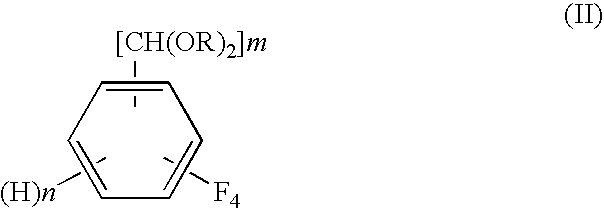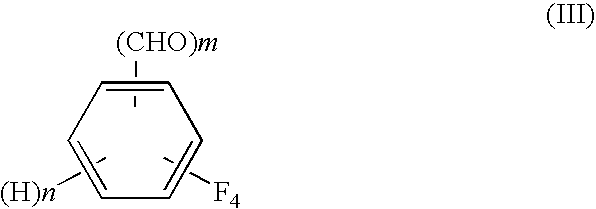Process for preparing tetrafluorobenzene carbaldehyde alkyl acetal
- Summary
- Abstract
- Description
- Claims
- Application Information
AI Technical Summary
Benefits of technology
Problems solved by technology
Method used
Image
Examples
example 1
[0055]In a conical flask, 20.6 g of 95% sulfuric acid was slowly added dropwise to 70 g (2.2 mol) of methanol with ice cooling. Then, into a 300-ml glass autoclave, the resulting sulfuric acid / methanol solution and a 5% Rh / C catalyst (available from NE Chemcat Corporation, hydrous product) in an amount of 0.25 g on a dry weight basis were charged. The system was purged with hydrogen to make a hydrogen pressure 0.1 MPa at room temperature. Heating of the autoclave and stirring of the contents in the autoclave were started, and the temperature was increased to 40° C. and was held constant for 1 hour. After the autoclave was cooled, 10 g (50 mmol) of tetrafluoroterephthalonitrile (available from Tokyo Kasei Kogyo Co., Ltd.) was fed to the autoclave, and the temperature was raised to 70° C. in a nitrogen atmosphere. At 70° C., introduction of hydrogen was started. The reaction pressure was controlled so that the hydrogen absorption rate should become not more than 10 ml / min. After a lap...
example 2
[0057]The same operations as in Example 1 were carried out, except that as a catalyst a 5% Pd / C catalyst (available from NE Chemcat Corporation, hydrous product) was charged in an amount of 0.25 g on a dry weight basis. After a lapse of 3.3 hours, absorption of hydrogen ceased. The quantity of hydrogen absorbed was 117% of the theoretical quantity of hydrogen absorbed. Treatment of the reaction solution was carried out in the same manner as in Example 1.
[0058]From the toluene extract, a small amount of a sample was withdrawn, and it was subjected to GC analysis. As a result of the analysis, a peak of the tetrafluoroterephthalonitrile as a raw material was below the detection limit, and the amount of tetrafluoroterephthalaldehyde was 68.9 mol %. On the other hand, the aqueous phase was neutralized and then subjected to GC analysis. As a result of the analysis, presence of 14.8 mol % of 2,3,5,6-tetrafluorobenzylamine was confirmed. The results are set forth in Table 1.
example 3
[0059]The same operations as in Example 1 were carried out, except that the temperature of the pretreatment of the catalyst with hydrogen was changed from 40° C. to 50° C. After a lapse of 5.5 hours, absorption of hydrogen ceased. The quantity of hydrogen absorbed was 106% of the theoretical quantity of hydrogen absorbed. Treatment of the reaction solution was carried out in the same manner as in Example 1.
[0060]From the toluene extract, a small amount of a sample was withdrawn, and it was subjected to GC analysis. As a result of the analysis, a peak of the tetrafluoroterephthalonitrile as a raw material was below the detection limit, the amount of tetrafluoroterephthalaldehyde was 89.4 mol %, the amount of 2,3,5,6-tetrafluorobenzene was 1.31 mol %, and the amount of 2,3,5,6-tetrafluorobenzonitrile was 1.03 mol %. On the other hand, the aqueous phase was neutralized and then subjected to GC analysis. As a result of the analysis, presence of 2.35 mol % of 2,3,5,6-tetrafluorobenzylami...
PUM
| Property | Measurement | Unit |
|---|---|---|
| Temperature | aaaaa | aaaaa |
| Temperature | aaaaa | aaaaa |
| Pressure | aaaaa | aaaaa |
Abstract
Description
Claims
Application Information
 Login to View More
Login to View More - R&D
- Intellectual Property
- Life Sciences
- Materials
- Tech Scout
- Unparalleled Data Quality
- Higher Quality Content
- 60% Fewer Hallucinations
Browse by: Latest US Patents, China's latest patents, Technical Efficacy Thesaurus, Application Domain, Technology Topic, Popular Technical Reports.
© 2025 PatSnap. All rights reserved.Legal|Privacy policy|Modern Slavery Act Transparency Statement|Sitemap|About US| Contact US: help@patsnap.com



